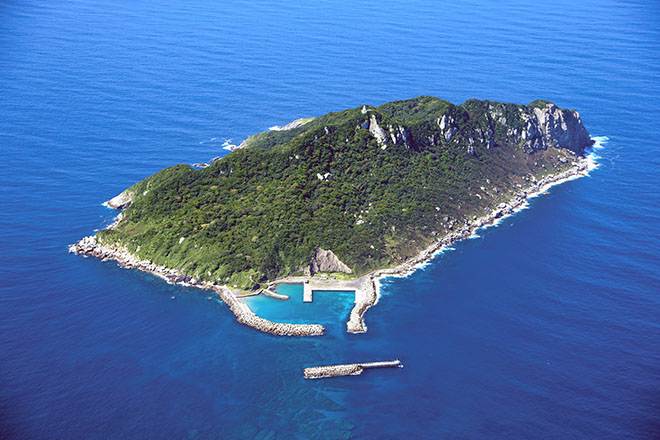Asahi Shinbun carries an exciting report today about possible Unesco recognition of Okinoshima as a World Heritage site in July. Though I’ve never been there, that sure is one place I’d love to get to one day. The photo shows you why…. (It’s timely too for me personally, since I’ve just been asked by Tuttle to do an update to my Japan’s World Heritage Sites book.)

Okinoshima island off the north coast of Kyushu (Asahi Shimbun file photo)
By YOHEI GOTO/ Staff Writer. May 6, 2017
A remote island in southwestern Japan that is deemed so sacred that women are not allowed to set foot on it has been recommended for World Heritage status by a UNESCO advisory panel, but with conditions. The streamlined listing would exclude shrines and a series of ancient burial tombs.
UNESCO’s World Heritage Committee will hold meetings in Poland from July 2 at which a final decision will be made on inclusion to the list.
Okinoshima island off the coast of the Fukuoka Prefecture cities of Munakata and Fukutsu is home to Munakata Taisha Okitsumiya shrine, which honors a goddess of the sea who is mentioned in “Nihon Shoki” (The Chronicles of Japan), one of Japan’s oldest official histories dating to the eighth century.
Because of the large number of artifacts uncovered, the island has been called the “Shosoin of the sea,” after the repository in Nara Prefecture erected to store the imperial family’s treasures as far back as the Heian Period (794-1185).
The recommendation, which reached the Japanese government on May 5, was compiled by the International Council on Monuments and Sites (ICOMOS), an advisory panel to UNESCO.
However, the recommendation said four other sites that the Japanese government included when it recommended the area to UNESCO be excluded.
Ancient religious taboos persist in Okinoshima, one of them being that no woman should ever step foot on the island. Access to the island is restricted, and visitors are not permitted to disclose details of their trip or bring back anything, not even a flower or a blade of grass as a keepsake.
Those are issues that will have to be dealt with if the listing goes ahead and steps are taken to develop the tourist potential and the local economy.
The sites that have been targeted for omission are the Okitsumiya Yohaisho and the Nakatsumiya shrine on Oshima island, which is located about 11 kilometers off the coast of Fukuoka Prefecture, as well as the Hetsumiya shrine and the Shinbaru-Nuyama mounded tomb group located in Munakata and Fukutsu cities, according to the Cultural Affairs Agency.
The ICOMOS report said those sites did not have the global value necessary for inclusion in the World Heritage List and also recommended that the candidate site name be changed to only mention Okinoshima.
An official with the Cultural Affairs Agency told reporters early May 6: “The archaeological value that was focused on ancient religious rites was the only factor positively appraised, but there was no appraisal of the fact that such religious belief has continued until the present day. To be honest, the report is a very severe assessment.”
Cultural Affairs Agency officials will consult with local authorities about the sites that were recommended for omission before deciding whether to petition for them to be included during the World Heritage Committee meeting in Poland.
The Council for Cultural Affairs, an advisory body to the Cultural Affairs Agency, recommended the entire site for inclusion in the UNESCO list in 2015.
Okinoshima lies about 60 kilometers off the coast of Fukuoka Prefecture and has a perimeter of about four kilometers. Three other small islets near Okinoshima have been included in the ICOMOS recommendation as they are considered strongly associated with Okinoshima.
Between the fourth and ninth centuries, important religious rituals hosted by the state were held on the rocky contours of Okinoshima to pray for safe passage of ships and good relations with the Korean Peninsula and China. Excavations carried out on the island after World War II turned up 80,000 artifacts.
These designated national treasures include copper mirrors, a gold ring, horse ornaments from the Korean Peninsula and glass beads that reached Japan via the Silk Road trade route that connected the Eurasian landmass with the far reaches of Asia.
**************
For more about the men-only controversy, see this article suggesting priestly reservations about the W.H. status.

Fascinating John. It sounds like an amazing place. No wonder Kyushu is called the gateway to Japan. I wonder if women will ever be able to visit the island? Congratulations on the request to update your WH book as well.